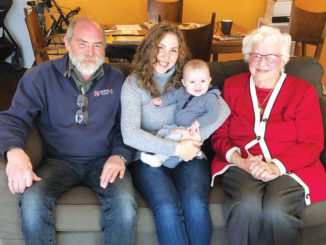
As a young girl from Arnprior, Pat Prentice headed off to Queen’s University in Kingston to pursue a Bachelor of Science in Nursing – then a five-year course, with the first and last years at the university, and the three middle years, in Pat’s case, spent at Hotel Dieu Hospital in Kingston.
With her freshly minted degree, in 1959 she headed to Toronto to teach at St. Michael’s Hospital School of Nursing. While there, she estimates she taught more than 2,000 student nurses. Then, as nurse training changed, she headed up the road to Ryerson to teach in their college nursing program. Plus she wrote a textbook on Huntington’s Disease for the Huntington Society of Canada, accompanied by films also made at Ryerson.
Feeling she needed a break, Pat headed off to the Ontario Institute for Studies in Education at the University of Toronto to acquire additional qualifications. This led her to Centennial College, where she became one of five people – and the only woman – teaching continuing education night school courses. When she got off the subway at the Warden Woods campus, there were cattle in the nearby fields by Providence Villa. Scarborough has changed mightily in the ensuing years. The place she taught had been part of the World War II munitions factory, with a still-functioning rifle range in the basement under her classroom.
Pat became interested in nursing homes and long-term care just at the time when Mary Ellen Glover started the Ontario Association of Residents’ Councils, and was hired as Mary Ellen’s assistant. They referred to themselves as “Slave A” and “Slave B,” since at that time they were the only staff, and were working hard to set up residents’ councils in all the long-term care facilities in Ontario, as had been recently mandated.
At the same time, she was part of a large group working with Ontario’s then Minister of Health, George Smitherman, on revising the act governing long-term care in Ontario. This momentous job took seven years. The one and only time Pat had visited Queen’s Park was to be in the gallery when the act was introduced.
She spent the past 10 years as a volunteer on the City of Toronto Advisory Committee for Long-Term Care, advising on the 10 long-term care facilities operated by the city. She retired only last month.
Today Pat is one of five people in an advocacy group called Concerned Friends, analyzing reports of inspections from the 627 long-term care facilities in the province. Concerned Friends work closely with the Ministry of Health to try to spot possible patterns or difficulties in particular homes, or a broader group.
In her early days in the city, Pat lived on Avoca Drive, and then on Bayview near Moore. In 1978, she bought her house on Leacrest, overlooking the valley. This led to her involvement in the Leaside Property Owners’ Association, when development was planned on Redway Rd. The original plans were much more extensive and more garish than the Loblaws there now. Pat certainly made sure she kept her eyes on how the development was proceeding. I remember her out with a flashlight, measuring brick dimensions to be sure they were as they were meant to be.
A stray collie-mix dog was part of Pat’s life for her first few years in the house. After that dog’s death, Pat acquired a Bichon Frise, called Dolly, from a woman in Etobicoke. Pat knew that name wasn’t going to work and asked a 6-year old neighbour to come up with an alternative. Toby, short for Etobicoke, lived with Pat until this past summer when she died at the age of 17.
If you haven’t caught Pat at LPOA meetings, you may see her at the Church of St. Anselm where she’s a reader at the 8am Tuesday mass and on the roster as a communion assistant on the weekends. As well, she is the dishwasher for the baking and cooking group which meets every Wednesday to prepare for the twice-yearly bazaars.
A going concern!





